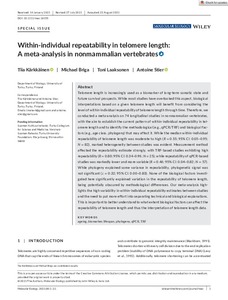Within-individual repeatability in telomere length: A meta-analysis in nonmammalian vertebrates
Kärkkäinen Tiia; Briga Michael; Laaksonen Toni; Stier Antoine
Within-individual repeatability in telomere length: A meta-analysis in nonmammalian vertebrates
Kärkkäinen Tiia
Briga Michael
Laaksonen Toni
Stier Antoine
WILEY
Julkaisun pysyvä osoite on:
https://urn.fi/URN:NBN:fi-fe2021120158335
https://urn.fi/URN:NBN:fi-fe2021120158335
Tiivistelmä
Telomere length is increasingly used as a biomarker of long-term somatic state and future survival prospects. While most studies have overlooked this aspect, biological interpretations based on a given telomere length will benefit from considering the level of within-individual repeatability of telomere length through time. Therefore, we conducted a meta-analysis on 74 longitudinal studies in nonmammalian vertebrates, with the aim to establish the current pattern of within-individual repeatability in telomere length and to identify the methodological (e.g., qPCR/TRF) and biological factors (e.g., age class, phylogeny) that may affect it. While the median within-individual repeatability of telomere length was moderate to high (R = 0.55; 95% CI: 0.05-0.95; N = 82), marked heterogeneity between studies was evident. Measurement method affected the repeatability estimate strongly, with TRF-based studies exhibiting high repeatability (R = 0.80; 95% CI: 0.34-0.96; N = 25), while repeatability of qPCR-based studies was markedly lower and more variable (R = 0.46; 95% CI: 0.04-0.82; N = 57). While phylogeny explained some variance in repeatability, phylogenetic signal was not significant (lambda = 0.32; 95% CI: 0.00-0.83). None of the biological factors investigated here significantly explained variation in the repeatability of telomere length, being potentially obscured by methodological differences. Our meta-analysis highlights the high variability in within-individual repeatability estimates between studies and the need to put more effort into separating technical and biological explanations. This is important to better understand to what extent biological factors can affect the repeatability of telomere length and thus the interpretation of telomere length data.
Kokoelmat
- Rinnakkaistallenteet [27094]
